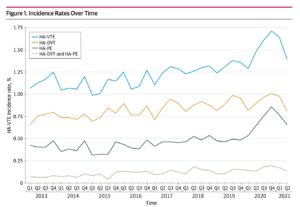Kaiser Permanente study finds incidence of this common complication is increasing
A new Kaiser Permanente study found the incidence of blood clots in hospitalized patients and those recently discharged has slowly been increasing over time, with the majority of these blood clots occurring after the patient has left the hospital. The findings, published November 21 in JAMA Network Open, support prior studies that have identified this trend.

“The reason for this increase is currently not known,” said lead author Elad Neeman, MD, a hematologist and oncologist with The Permanente Medical Group. “Several factors are thought to be in play — increased awareness and testing for blood clots, more accurate tests, a trend toward home recovery, which increases the fraction of sicker patients in the hospital, an aging population, and, of course, COVID-19, which has been shown to increase risk of blood clots in hospitalized patients.”
The study found 13,843 blood clots — deep vein thrombosis or pulmonary embolism — recorded among 1,112,014 admissions at Kaiser Permanente Northern California hospitals between 2013 and 2021. The patients who experienced a blood clot were more likely to be older, to have been hospitalized more often, and to have received medication to prevent a blood clot during their first 48 hours in the hospital than those who did not develop blood clots.

The study found that, over time, the number of blood clots in patients increased from 1.1% of admissions in the first 3 months of 2013 to 1.6% of patients in the first 3 months of 2021. The study also found that blood clots occurred more often in the 90 days after patients were discharged than they did while patients were hospitalized.
“Blood clots result in increased pain and suffering and higher rates of readmission, death, and risk of future blood clots,” said Neeman. “We can treat blood clots with strong blood thinners, but these medications can cause bleeding and other severe complications, which is why we always want to try to prevent them.”

Neeman is currently working with study co-author research scientist Vinnie Liu, MD, MS, and other investigators at the Division of Research to develop a tool that can scan a patient’s electronic health record at the time of a hospital admission and automatically calculate their risk of developing a blood clot. Physicians would use this calculation along with other information about the patient to help determine which patients should receive treatment to prevent blood clots.
“Our findings suggest that using our large databases produces more accurate tools compared to those that have previously been developed, and that these tools also seem to perform better than providers’ subjective assessments of blood clot risk,” said Liu. “Our goal is to help physicians and patients by introducing the tools into our Kaiser Permanente Northern California hospitals in the near future.”
Neeman said patients and their family members can take steps to reduce their risk for blood clots before and after hospitalization. “The most important thing you can do is early and frequent movement, because moving your limbs helps prevent blood clots,” he said. “If your medical team allows it, going on walks, standing, and spending time sitting rather than lying down can help. Also, if you notice symptoms of a blood clot, such as swelling, pain, or redness in one arm or leg, or sudden chest pain or shortness of breath, tell your providers right away.”
The study was supported by The Permanente Medical Group.
Co-authors include Pranita Mishra, MPP, Khanh K. Thai, MS, Heather Clancy, MPH, and David Schlessinger, PhD, of the Division of Research; and James Xu, MD, and Raymond Liu, MD, of The Permanente Medical Group.
# # #
About the Kaiser Permanente Division of Research
The Kaiser Permanente Division of Research conducts, publishes and disseminates epidemiologic and health services research to improve the health and medical care of Kaiser Permanente members and society at large. It seeks to understand the determinants of illness and well-being, and to improve the quality and cost-effectiveness of health care. Currently, DOR’s 600-plus staff is working on more than 450 epidemiological and health services research projects. For more information, visit divisionofresearch.kaiserpermanente.org or follow us @KPDOR.





This Post Has 0 Comments